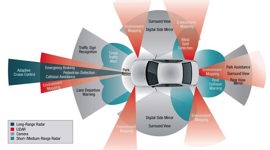Infiniti will be showing off a pair of new cars at the Geneva Motor Show next week. There will be a refreshed Q50 sedan, but the big news is Project Black S: a new high-performance hybrid coupe.
Project Black S is a collaboration between Infiniti and the RenaultSport Formula 1 team. Based on the 2017 Infiniti Q60 coupe, it has F1-inspired aerodynamics. Like modern Formula 1 cars, it's a hybrid. The Project Black S uses an energy recovery system, like an F1 car, to harvest energy. Not just saving it under braking like a conventional hybrid, but also recovering energy from the exhaust to be used as electric power when you want more acceleration. Infiniti says this type of hybrid system has never been used before in a road car. They're holding off on saying what the gas engine will be and the total power numbers for now.
The outside has a massive front splitter with gaping air intakes. The hood has a pair of large extractor vents. Wide side skirts run the length of the car between the wheels. At the back is an absolutely enormous dual element rear wing. Look past the wing and there is a large rear diffuser with two center-exit exhaust tips.
Infiniti says that the concept is meant to test public interest in high-performance cars from the brand. The Black S name refers to the red S that marks Infiniti's current high-performance trim. This new Black S will sit above those. If it generates a buzz, we could see a production version of the Project Black S, along with other higher-performance Infinitis.

If you're thinking that the 2017 Infiniti Q50 just got an update, you're right. The changes for 2016 added some new engines, including Infiniti's newest 3.0L twin-turbo V6. This time will be more of a cosmetic makeover inside and out, although they aren't showing the inside until next week. The photo they released does show off a new front bumper. The new car will have the second-generation of Infiniti's Direct Adaptive Steering. That's Infiniti's steer-by-wire system, and the company says that it has been improved for smoother operation, more direct response, and better maneuverability, as well as providing the technical basis for upcoming fully autonomous systems.










